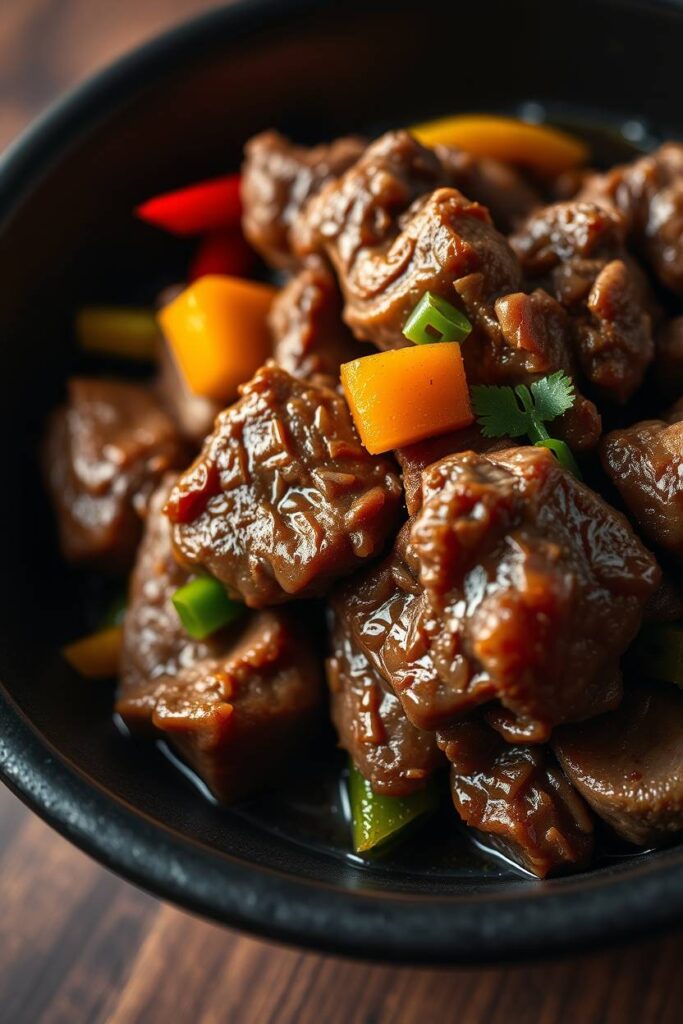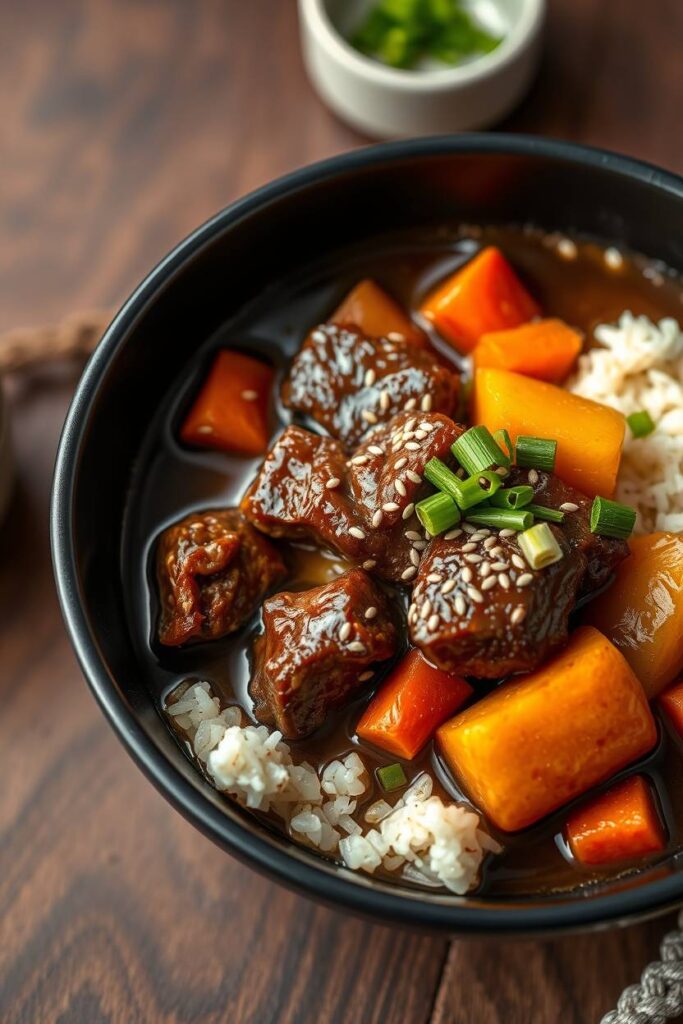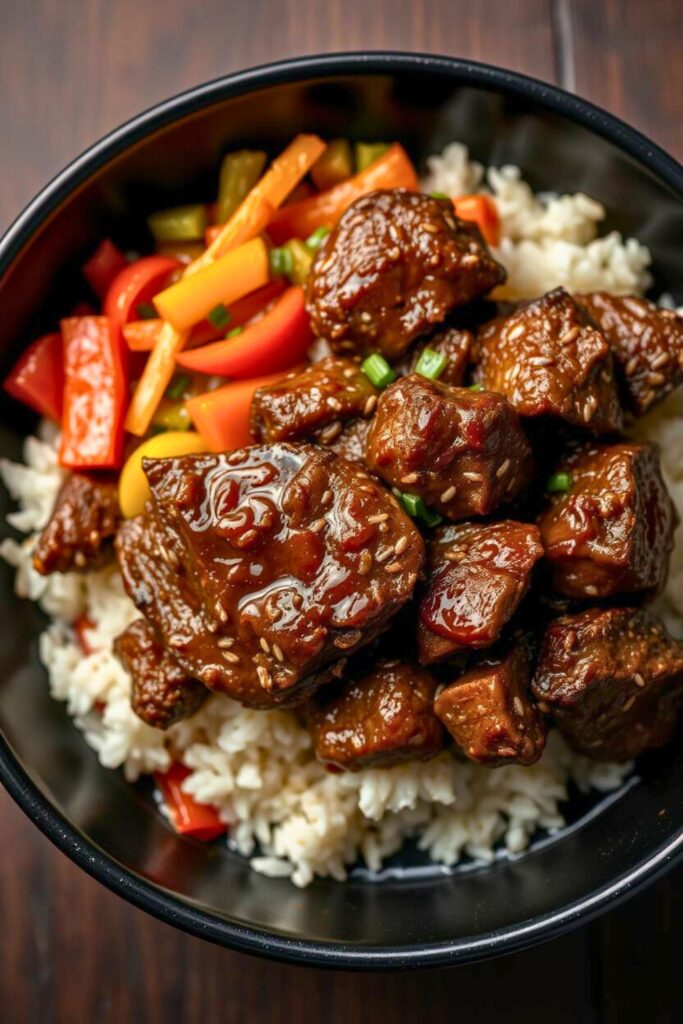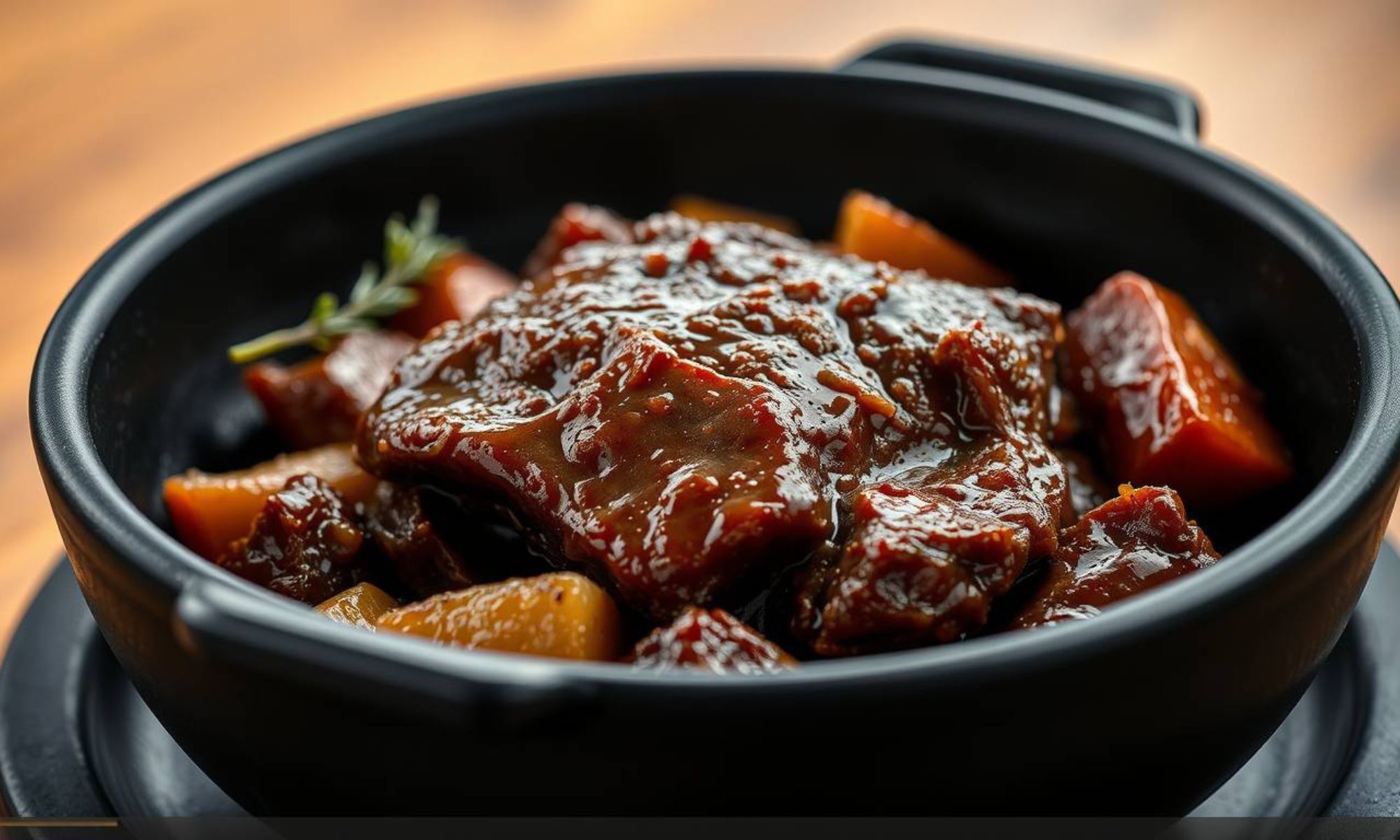Forget what you know about pot roast.
No, really, set aside the carrots, the overused rosemary, and the predictability of it all. This Korean Style Pot Roast doesn’t play by the old rules. It’s what happens when slow braised comfort food gets a fiery, flavor packed upgrade, from the gentle soul of Sunday dinner to something that crackles with spicy sweet Korean intensity.
I didn’t come up with this recipe in some calm, curated kitchen moment. I was juggling a Zoom call, burning rice, and mentally rewriting my grocery list when I remembered a chuck roast I’d shoved in the back of the fridge two days ago. The classic pot roast playbook felt too safe. Too soft spoken for the day I was having. So I tossed it. The playbook, that is. Not the roast.
What came next was loud, in flavor, in aroma, and in satisfaction. I hit that beef with sesame oil, a slick of gochujang, fresh ginger, and a generous pour of soy sauce. It sizzled, hissed, and transformed my kitchen into something that smelled part street market, part family kitchen. No carrots. No potatoes. Just depth, heat, sweetness, and that slow cooked tenderness we all secretly need after a long day.
You’re not here for the usual. And this dish? It’s anything but.
Stay with me. I’ll walk you through how to bring this Korean Style Pot Roast to life, with step by step tips, smart shortcuts, and cozy serving ideas that’ll have you making it again before the week’s even over.
Why This Pot Roast Changes Everything
Korean Style Pot Roast bridges two comfort food worlds brilliantly. American slow cooking meets Korean pantry staples in ways that just work.
Gochujang brings this incredible depth, sweet, spicy, funky from fermentation. It transforms during hours of cooking. Sharp edges mellow into rich complexity.
Asian pear isn’t just sweetness. Natural enzymes tenderize tough meat fibers. Traditional Korean marinades rely on this fruit for good reason.
After tasting this version, regular pot roast feels bland. Bold Korean flavors bring every bite to life.
Essential Korean Style Pot Roast Ingredients

The Supporting Cast
Here’s what makes Korean Style Pot Roast sing, listed in cooking order:
Chuck roast (3-4 pounds): Fat marbling equals flavor explosion. Don’t go lean here.
Gochujang (3-4 tablespoons): Korean chili paste that’s sweet, spicy, complex. Find it in most grocery stores now.
Soy sauce (1/2 cup): Choose low sodium. You control the salt level.
Asian pear (1 large, grated): Natural meat tenderizer that adds subtle sweetness.
Brown sugar (1/4 cup): Balances the heat perfectly.
Rice wine vinegar (2 tablespoons): Cuts through richness with bright acidity.
Garlic (6 cloves, minced): Fresh only. Powder won’t cut it here.
Fresh ginger (2-inch piece, grated): Frozen ginger actually grates easier.
Smart Korean Pot Roast Swaps
No gochujang? Mix sriracha with brown sugar and tomato paste. Close enough to work.
Missing Asian pear? Regular pear works. Apple with rice vinegar pinch hits too.
Can’t find rice wine vinegar? White wine vinegar plus sugar substitute works fine.
The Supporting Cast
Yellow onion (1 large): Thick wedges break down into sauce magic.
Carrots (4 large): Chunky pieces hold their shape through long cooking.
Baby potatoes (1 pound): Leave whole. They absorb Korean flavors like sponges.
Beef stock (2 cups): Low sodium preferred. Control your salt levels.
Sesame oil (2 tablespoons): Final nutty Korean touch.
Green onions (4-5 stalks): Fresh garnish brightens everything.
Step by Step Braised Beef Magic

Getting That Perfect Sear
Remove chuck roast from fridge 30 minutes early. Cold meat doesn’t sear properly.
Pat roast bone dry with paper towels. Moisture steams instead of searing.
Season generously with salt and pepper. Big meat needs bold seasoning.
Heat Dutch oven over medium high with neutral oil. Wait for shimmering, not smoking.
Sear roast 3-4 minutes per side without moving. Golden brown crust develops flavor.
Building Korean Flavor Foundation
Remove seared roast. Keep those brown bits, they’re flavor gold.
Add onion wedges to same pot. Medium heat softens them in 5 minutes.
Add garlic and ginger. Stir constantly for 30 seconds until fragrant.
Longer cooking burns them. Burned aromatics taste bitter.
Creating the Sauce
Whisk gochujang, soy sauce, brown sugar, rice vinegar together. Gochujang resists mixing initially, keep whisking.
Add grated Asian pear. Stir until combined completely.
Pour mixture into pot with softened onions. Bubble 2 minutes, stirring constantly.
The aroma hits you like Korean comfort food magic.
The Long Journey to Korean Pot Roast Perfection
Nestle seared roast back into the aromatic pot. Add beef stock halfway up the roast.
Add water if needed for proper liquid level.
Bring to gentle simmer. Cover, transfer to 325°F oven.
Plan 3 hours for 3-pound roast. Patience creates perfection.
Add carrots and potatoes after 2 hours. Vegetables need less cooking time.
Remove lid final 30 minutes. Liquid reduces into glossy sauce.
The Korean Style Pot Roast Finale
Test doneness with fork. Meat should fall apart easily.
Tough meat needs another 30 minutes. Don’t rush perfection.
Rest roast 10 minutes before slicing. Strain cooking liquid, skim excess fat.
What remains is Korean Style Pot Roast liquid gold.
The Science Behind Korean Style Pot Roast Success
Gochujang contains enzymes that break down proteins during cooking. Sugars caramelize, creating complex flavor layers.
Asian pear enzymes naturally tenderize tough chuck roast. Traditional Korean technique meets American comfort.
Long, slow cooking transforms collagen into silky gelatin. That’s what creates fork tender texture.
Dutch oven prevents hot spots better than slow cookers. Even heat distribution matters for Korean Style Pot Roast.
Heavy lid traps moisture while allowing flavor concentration.
Making It Instagram-Worthy

Slice against grain into thick, overlapping pieces. Arrange on serving platter with style.
Spoon glossy sauce over meat, letting it pool attractively.
Garnish with chopped green onions and sesame seeds. Color contrast creates visual drama.
White plates make Korean Style Pot Roast colors pop dramatically.
Perfect Korean Style Pot Roast Pairings
Steamed white rice soaks up incredible sauce perfectly. Buttery mashed potatoes work equally well.
Steamed broccoli or sautéed bok choy complement without competing. Keep vegetables simple.
Rich Pinot Noir or medium Malbec stand up to bold Korean flavors. Full bodied Chardonnay works for white wine lovers.
Final Thoughts: Where Comfort Meets Korean Soul
Korean Style Pot Roast isn’t just a twist, it’s a transformation. This dish bridges comfort and complexity, taking the cozy essence of a slow-cooked roast and layering it with bold Korean flavors that linger long after the last bite. It doesn’t aim to imitate tradition. Instead, it creates something new. Familiar yet exciting, rooted in technique but fearless in taste.
Whether it’s your first time working with gochujang or your fiftieth Sunday roast, this recipe offers more than a meal. It’s a flavor story that evolves in your kitchen, improves by the day, and earns its place in your comfort food rotation.
So go ahead, skip the carrots, keep the soul, and make your pot roast unforgettable.
Let the aroma pull you in, the sauce win you over, and the tenderness remind you why slow food still wins. One bite, and you’ll never go back to ordinary
Frequently Asked Questions
Can I make Korean Style Pot Roast in a slow cooker?
Yes, absolutely! For best flavor, sear the chuck roast in a hot skillet first to build that deep, caramelized crust. Then transfer it to your slow cooker with the remaining ingredients. Cook on low for 6–8 hours. The texture will be more pulled and tender than sliceable. The flavor still shines, rich and satisfying, even without the oven.
How spicy is Korean Style Pot Roast with gochujang?
Gochujang adds a sweet, smoky heat—not a fiery one. Its spice mellows during slow cooking, creating balance and complexity without overpowering the dish. Start with 2 tablespoons if you’re spice-sensitive; add more next time if you like it bolder. It’s approachable and flavorful, making it a great introduction to Korean heat.
What’s the best way to store Korean Style Pot Roast leftovers?
Store the beef and sauce together in an airtight container in the refrigerator for up to 4 days. The sauce may thicken in the fridge due to natural gelatin, totally normal. When reheating, use a splash of beef broth and warm gently on the stove. Slow reheating keeps the meat tender and juicy. It tastes even better the next day.
Can I freeze Korean Style Pot Roast successfully?
Yes, it freezes beautifully! Let the roast cool completely, then portion it with the sauce into airtight containers. Freeze for up to 3 months. When ready to enjoy, thaw overnight in the fridge and reheat gently with added broth or water. While the vegetables may soften, the flavor stays deep, rich, and comforting, perfect for make-ahead meals.
What if I can’t find Asian pear?
If Asian pear isn’t available, don’t worry. Grated Bosc or Anjou pear works well and still adds sweetness and moisture. You can also use grated apple with a splash of rice vinegar to mimic the effect. If neither is an option, add extra brown sugar, but you’ll lose the natural tenderizing enzymes found in the fruit

Swiftly Captions by Tina Smith — Quick, flavorful food recipes made simple, bringing fresh inspiration to your kitchen every day






